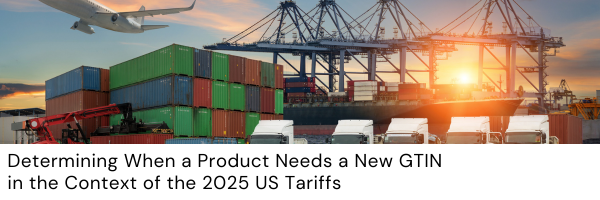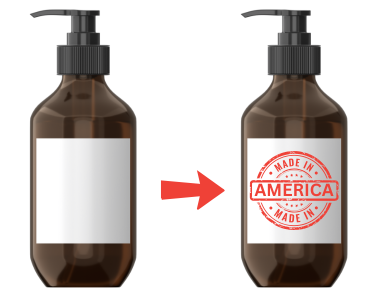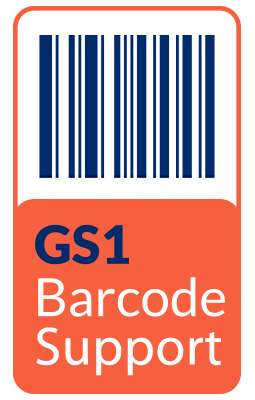As the consequences of the April 2025 U.S. tariffs are being digested, businesses are strategizing on shifting manufacturing to the US or to countries with lower tariffs to avoid steep costs. But amid this scramble, a pressing question looms: When does moving production to a new country require a new Global Trade Item Number (GTIN)?
This isn’t just a technical detail—it’s a decision that could ripple through your supply chain, affecting inventory tracking, compliance, and customer trust. This article will dive into the GS1 guidelines, unpack real-world triggers, and offer a clear roadmap to decide when a new GTIN is necessary.
Understanding the Basics: GTINs and Country of Origin
GTINs are standardized unique identifiers used on products worldwide. Per the GS1 General Specifications and GTIN Management Standard, a new GTIN is required when a material change affects:
- Identification: Changes in formulation, functionality, or packaging.
- Trade: Impacts on compliance or supply chain processes.
- Perception: Shifts noticeable to consumers or partners.
The core rule? A change in manufacturing location alone doesn’t mandate a new GTIN if the product’s specs, functionality, and appearance remain unchanged. For example, moving toy production from China to Vietnam without other updates typically allows the existing GTIN to stay.
When the 2025 Tariffs Can Trigger a GTIN Change
The 2025 tariffs introduce scenarios where a new GTIN may be necessary. Here are three key triggers:
1. Country of Origin Labeling Requirements
Shifting production to avoid tariffs—say, from China to Mexico under the USMCA—often requires updating the country of origin on packaging for customs compliance.
- Why it matters: If this update alters consumer-facing labels, GS1 guidelines recommend a new GTIN.
For instance, consider a company that relocates its electronics production from China to the U.S. to eliminate tariffs. To convey this change, they add a prominent “Made in America” label on the packaging, aiming to appeal to consumers who value domestic goods. This isn’t just a minor tweak—it’s a deliberate marketing move that could sway purchasing decisions.
GS1 advises a new GTIN here to distinguish this product from its prior version, ensuring clarity in the supply chain. Even smaller changes, like updating a tag from “Made in Vietnam” to “Made in Canada,” may require a new GTIN if visible to consumers.
2. Changes to Trade Classification and Processing
Tariff-driven moves can shift trade logistics:
- New HTS (Harmonized Tariff Schedule) codes may apply.
- Documentation or trade benefits (e.g., duty-free status) might change.
- Why it matters: Major changes in classification or tracking may necessitate a new GTIN.
- Example: A furniture maker relocating production for tariff relief might face new import codes, prompting a GTIN update.
3. Trading Partner Requirements
Your partners might demand more than GS1 requires:
- Unique GTINs to track products by origin.
- New identifiers for compliance or inventory needs.
- Why it matters: The GS1 GTIN Management Standard supports new GTINs to meet partner expectations.
- Example: A retailer might require a new GTIN for widgets made in Mexico versus China to simplify tracking.
Decision Framework: Do You Need a New GTIN?
Use these questions to decide:
Does the change affect product labeling?
- Yes: If the origin updates packaging, consider a new GTIN.
- No: If it’s a backend shift, keep the current GTIN.
Does the shift impact regulatory compliance?
- Yes: If new rules or certifications apply, assign a new GTIN.
- No: If compliance is unchanged, stick with the existing one.
Is the country of origin a key attribute?
- Yes: For goods where origin influences buyers (e.g. food), use a new GTIN.
- No: If it’s irrelevant, maintain the current GTIN.
What do your trading partners expect?
- Ask retailers or distributors—some may require new GTINs for origin-specific needs.
Practical Implementation
If you decide not to change a product’s GTIN based on the above decision criteria, you still need to update current databases, such as GTIN.cloud and Google Merchant Center and update the “country of origin” parameter. This information is still valuable and it is imperative to remain current on even minor changes. GS1 Barcode Support members can work with their assigned consultant on updating these existing fields.
Following GS1 best practices when assigning a new GTIN, companies should plan for a smooth transition period where both old and new GTINs can coexist in the supply chain, ensuring trading partners have adequate time to update their systems. GS1 recommends maintaining clear communication with all supply chain partners during this transition, providing advance notification of the GTIN change and specific dates for when the new GTIN will begin appearing in orders and shipments.
Conclusion
Moving manufacturing to avoid the 2025 tariffs doesn’t always require a new GTIN—but changes like a prominent “Made in America” label, trade shifts, or partner demands often do. By aligning with GS1 standards and your business needs, you can ensure supply chain clarity and maintain a competitive edge in a shifting trade landscape.







Comments are closed.